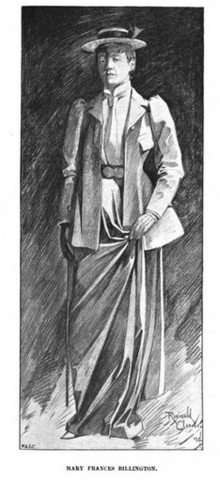Mary Frances Billington

Mary Frances Billington (6 September 1862 – 27 August 1925) was an English journalist and writer, whose collected articles on women were published as Woman in India (1895),[1] The Red Cross in War (1914)[2] and The Roll-Call of Serving Women (1915).[3]
Early life
Mary Frances Billington was born at Chalbury Rectory, in Chalbury, Dorset. Her father, George Henry Billington, was a clergyman, the rector at Chalbury; her mother Frances Anne Barber Billington was a clergyman's daughter before she was a clergyman's wife.[4]
Career
Mary Frances Billington helped establish the Southern Echo newspaper in 1888, and was recruited from there to the London office of the Echo by John Passmore Edwards. Billington joined the staff of the Daily Graphic at its founding in 1890.[5] Some of her journalism during this job included diving underwater in full gear at the Royal Navy Exhibition, and covering the funeral of Alfred, Lord Tennyson at Westminster Abbey. In 1897, she moved to the Daily Telegraph. She was in charge of the women's department at the Telegraph, and wrote a weekly column that focused on women's working lives.[6] Her 28 reports filed with the Graphic from India were compiled as her first book, Woman in India (1895).[7][8]
During World War I, Billington reported from France, and published two more books of her columns, this time focusing on women's wartime work: The Red Cross in War: Women's Part in the Relief of Suffering (1914) and The Roll Call of Serving Women: A Record of Woman's Work for Combatants and Sufferers in the Great War (1915). In a 1914 article about the war for The Girl's Own Paper, she warned against inexperienced knitters making socks for soldiers, noting, "it is very important that a soldier should not get sore feet."[9]
Billington was one of the founders and president of the Society for Women Journalists from 1913 to 1920, and served on the executive council of the Cowdray Club.[10] She served as the only woman delegate to the 1920 Imperial Press Congress when it was held in Ottawa, Canada.[11]
Personal life
Mary Frances Billington died at home in London in 1925, a week short of her 63rd birthday.[10] Her remains were buried at the churchyard in Chalbury, with those of her parents and her brothers.[12]
References
- ↑ Mary Frances Billington, Woman in India (Chapman & Hall 1895).
- ↑ Mary Frances Billington, The Red Cross in War (Hoder and Stroughton 1914).
- ↑ Mary Frances Billington, The Roll-Call of Serving Women (London 1915).
- ↑ Fred Hunter, "Billington, Mary Frances (1862–1925)" Oxford Dictionary of National Biography (Oxford University Press 2004).
- ↑ Mary A. Bellington, "Lady Journalists: Sketches of Some of the Most Prominent of Them, Who Do Work on Foreign Papers" Atlanta Constitution (18 December 1892): 34. via Newspapers.com

- ↑ Barbara Onslow, "Mary Frances Billington" in Laurel Brake and Marysa Demoor, eds., Dictionary of Nineteenth-Century Journalism in Great Britain and Ireland (Academic Press 2009): 54. ISBN 9789038213408
- ↑ Teresa de Ataíde Malafaia, "Cultural Diversity and Conflicts in Mary Frances Billington's Woman in India" in Ana Cristina Mendes and Cristina Baptista, eds., Reviewing Imperial Conflicts (Cambridge Scholars Publishing 2014): 138-144. ISBN 9781443858793
- ↑ Indrani Sen, "Devoted Wife/Sensuous Bibi: Colonial Constructions of the Indian Woman, 1860-1900" Indian Journal of Gender Studies 8(1)(2001): 1-22.
- ↑ Peter Hunt, "Prophesying War: The Hidden Agendas of Children's Literature in 1900-1914...and 2015" in Lissa Paul, Rosemary R. Johnston, and Emma Short, eds., Children's Literature and Culture of the First World War (Routledge 2015): 326. ISBN 9781317361671
- 1 2 "Woman Journalist Dead; Mary Frances Billington" The Argus (29 August 1925): 31. (via Trove)
- ↑ "Press Women Greet Sister from Britain; Miss Mary Frances Billington Gives Resume of Early Days of Sex in Journalism" Winnipeg Tribune (16 August 1920): 9. via Newspapers.com

- ↑ Chalbury, All Saints Church, burial ground, memorial inscriptions.